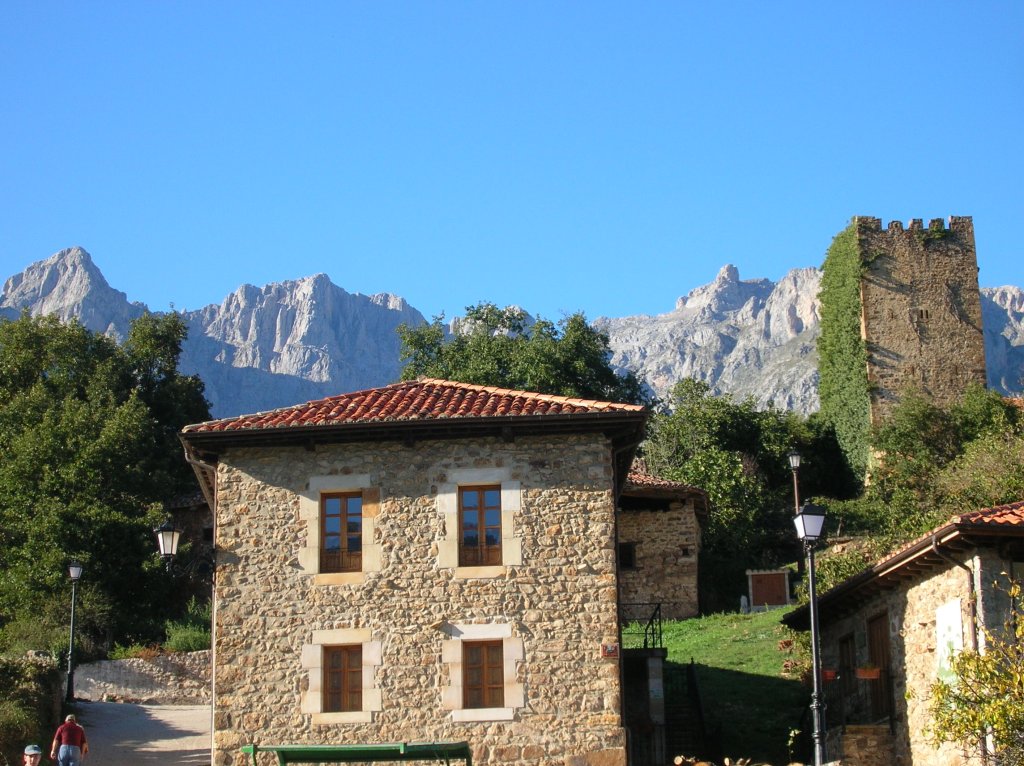Walking the Camino Lebaniego Guide
The particularity of the Camino Lebaniego is that, although it is part of the network of the Camino de Santiago, it has its own final place of veneration, the monastery of Santo Toribio de Liébana.
And why is the Camino Lebaniego part of the Camino de Santiago if it does not go to Santiago? Because it is itself a detour of the Northern Way which, crossing Cantabria, joins the French Way in the town of Mansilla de las Mulas. This section between the Northern Way and the French Way is called the Camino Vadiniense.
The Camino Lebaniego is a short pilgrimage, which takes you from San Vicente de la Barquera, on the coast of Cantabria, to the monastery of Santo Toribio de Liébana, at the foot of the Picos de Europa in 3 or 4 stages. If you do not have time to go all the way to Santiago, get to Santo Toribio! There you can also obtain eternal forgiveness, according to Christianity.
It is a short, uncrowded Camino, and less physically demanding, but with some fairly long stages and stretches of road. Outside the peak season, it can be difficult to find accommodation, but the route and the scenery are well worth the effort.
.jpg) |
.jpg) |
.jpg) |
.jpg) |
History of the Camino Lebaniego
The Camino Lebaniego dates back to the Middle Ages, when pilgrims would detour from the northern Camino de Santiago to visit the monastery of Santo Toribio and venerate the Lignum Crucis (‘wood of the cross’), the largest known piece of the cross where Jesus was crucified.
This piece of wood was brought by monks from Astorga in the 9th century to avoid its destruction by the Muslim invasion that was approaching the north of the peninsula. The relic arrived along with the remains of Saint Toribio of Astorga, who guarded and imported the Lignum Crucis from Rome.
In 1512, the monastery of Santo Toribio received, from Pope Julius II, the privilege of celebrating a holy year whenever the 16th of April (the day of Santo Toribio's birth) coincided with a Sunday, making it a sacred place for Christianity. This fact further encouraged pilgrims to visit the site, as a detour from the Northern Way to worship the piece of wood and join the French Way.
Today, the Camino Lebaniego continues to attract devotees from all over the world as well as those looking for a Camino in the middle of nature. The route combines the coast, the spectacular Lebaniego valleys, the Hermida Gorge and the mountains of the Picos de Europa, all in less than a week!
Location
The Camino Lebaniego runs entirely in the province of Cantabria, in the north of Spain. The monastery of Santo Toribio is located 3km from the medieval village of Potes, in the Liébana Valley, surrounded by mountains.
Map
In this map you can see the route of the Camino Lebaniego.
Starting & End Points
The Camino Lebaniego begins in the coastal town of San Vicente de la Barquera and ends at the monastery of Santo Toribio located in the municipality of Camaleño, in the Liébana region.
Distance and Walking Length
The Camino Lebaniego has a total of 72 km (45 miles) which are usually divided into 3 stages of 28, 30 and 14 km (17, 19 and 9 miles respectively), although there is the option of shortening the first two stages by adding an extra night.
Difficulty
The Camino Lebaniego is technically easy and, although it can be done in 3 stages, the first two are quite long (up to 30 km) and with long stretches of road, so many pilgrims add an extra night, reducing the distances to about 20 km (12 miles) per day.
As the route progresses, the stretches of road are gradually reduced and the landscape becomes more mountainous, but this does not affect the difficulty of the route.
Route
The Camino Lebaniego is a charming pilgrimage as it combines coast, mountains and varied landscapes in just a few days. The villages and monuments through which it passes also attract the attention of the pilgrim.
The start in San Vicente de la Barquera is already spectacular, a coastal village built on top of a hill and with a breathtaking view of the Picos de Europa. Turning our backs to the sea, we begin to walk towards the interior of Cantabria, following the River Nansa.
From the village of Cades, where you will probably spend the night, there is a somewhat tedious stretch of road. It is part of the Camino, the only purpose of which is to reach the place of devotion as quickly as possible. Before setting off, visit the Cades forge, an 18th century hydraulic forge that can still be seen in operation.
Once you reach Lafuente, say goodbye to the road and enter the countryside again. Here you have to climb 325m to overcome a pass that separates you from Cicera, a village but with a pilgrims' hostel, a couple of hotels, rural houses and a restaurant.
And now you are on the last stage, probably the most beautiful and with the most nature, crossing two passes and the Hermida gorge. Apart from the scenery, the route takes you past two architectural gems: Santa Maria de Lebeña, a pre-Romanesque jewel built in Mozarabic style by Christians who fled from Moorish territory, and Potes, capital of the region and one of the most beautiful villages in Spain, full of charming corners and medieval buildings.
Once in Potes, you can continue for a further 2.7 km (1.6 miles) until you reach the monastery of Santo Toribio, the end of the Camino Lebaniego, or rest and spend the next morning completing the pilgrimage. And for those of you who have not had enough of 3 or 4 days on the route, the Picos de Europa are just a stone's throw away.
 |
.jpg) |
Accommodation
Accommodation is easy to find at the beginning and end of the Camino Lebaniego, but it is scarce in the areas between. In this section, there are rural houses and some hostels, but it is difficult to adjust the kilometres of each stage to suit your convenience, and even more so out of season, when most of the accommodation closes. In these cases, the usual thing to do is to call a taxi to take you to the next accommodation, or to take you back to the previous one and resume the route at the same point the next morning.
Weather and Best Time
The Camino Lebaniego can be done from early spring to late autumn. The Atlantic climate is most pleasant in summer, with frequent rainfall and mild temperatures, but changes to a drier and hotter climate as we reach the valley of Liébana. Even though it is northern Spain, it can be especially hot in July and August due to its microclimate.
Apart from the temperatures, the area is particularly popular from the second half of July to the end of August, so it is best to plan your Camino outside these times. This will allow you to choose the accommodation you want as, in high season, many will ask for a minimum stay of 2 nights or more.
Getting There
It is relatively easy to get to San Vicente de la Barquera. From Santander or Bilbao airports or train stations, you can take an ALSA bus to San Vicente.
At the end of the Camino, you can take a bus from Potes with stops in Unquera, S. Vicente de la Barquera, Torrelavega or Santander.
In the case of travelling by car, you can leave it in San Vicente and return at the end of the route, or go to Potes and take a bus to San Vicente, so that you will have your car ready at the end to return home or continue exploring the area.
By air
There are several domestic flights, and the frequency and destinations are increasing. If you are coming from a long international flight, you will probably land in London, Paris or Madrid. From there you can take a flight to Bilbao or Santander airport, both of which are connected to San Vicente de la Barquera by bus.
By train
San Vicente de la Barquera is connected by FEVE, RENFE's narrow-gauge trains, with cities such as Santander, Oviedo and Bilbao. They are small trains, with some beautiful stretches of route, but the frequency is low, so you should check the timetable carefully before making plans.
By bus
The boom of bus companies with international routes connects Bilbao, Santander or Llanes with the rest of Spain or Europe. The biggest companies are ALSA, Eurolines, Flix, Ouibus, ...
Best places en route
- The Oyambre Nature Reserve, to the north and east of San Vicente de la Barquera. This is the mouth of the River Nansa, which is transformed into salt marshes, an important refuge for many migratory birds.
- The river trail runs between Muñorrodero and Camijanes, a delightful stretch along the River Nansa, with lots of trees and shade, ideal in summer, and several places to sit down for lunch and to recharge your batteries.
- La Encinona de Cabanzón, a thousand-year-old holm oak with a perimeter of 4 metres. You will find it in the village of Cabanzón, between San Vicente and Cades.
- El Habario de Pendes, a group of more than 200 chestnut trees (some of them over a thousand years old) distributed on a hill above the village of Pendes. Surrounded by these trees, you will have stunning views of the Picos de Europa and the mountains in the area.
- The Picos de Europa, with an entity of their own and which you will gradually approach as you advance along the Camino Lebaniego. Near the end of the route, in Tama, there is a visitor centre dedicated to the Natural Park. And if you still have enough energy left, you can add an extra day's hiking, for example, by taking the Fuente De cable car.
Top tips for pilgrims walking the Camino Lebaniego
- As we have mentioned, the Camino Lebaniego does not have a great infrastructure for the pilgrim as other more popular routes. Plan each day where you can get food and if you need to buy provisions for dinner, as some accommodations are located in somewhat remote places and there are almost no restaurants.
- Get a pilgrim's credential before starting the Camino. Like the Camino de Santiago, you must stamp your passport to get La Lebaniega, a certificate issued by the monastery of Santo Toribio that certifies that you have completed the Camino Lebaniego.
- If you have more time, do not miss the opportunity to spend an extra night in Liébana and take a ride in a cable car to Picos de Europa in Fuente Dé.




Opening hours: Mon-Fri 9:00am – 6:00pm (CET)
Opening hours: Mon-Fri 9:00am – 6:00pm (CET)